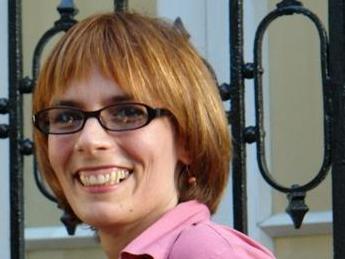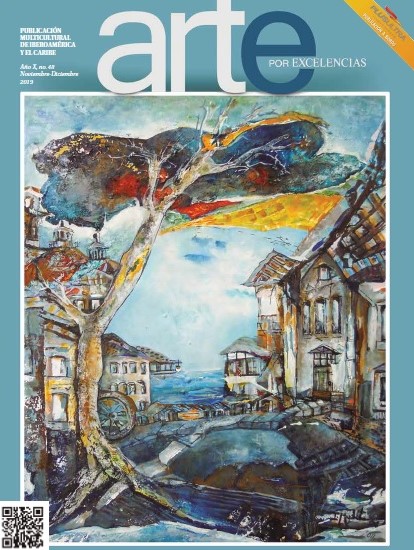 The magnitude of the projects she is involved in since early this year and her passion for them is such that one cannot calculate the extent of an interview with Isabel María Pérez Pérez, the director of Artecubano Editions, a woman that, additionally for any journalist, has the gift of speech.
The magnitude of the projects she is involved in since early this year and her passion for them is such that one cannot calculate the extent of an interview with Isabel María Pérez Pérez, the director of Artecubano Editions, a woman that, additionally for any journalist, has the gift of speech.
There are three unavoidable issues that led Cubarte to her office. We decided to start by dealing with the issue that keeps her awake during these days: the mega-exhibit Zona Franca (Free Zone) that, as one of the collateral exhibitions of this edition of the Havana Biennial, will occupy on May 21st the whole area of the Morro-Cabaña Military Historical Park.
“How did you come to be involved in this project?
"The Editorial is an institution of the National Council of Plastic Arts (CNAP) that during the last four years has had a greater relationship with the curators for it has coordinated all the works with the collection of CNAP.
The group of curators of the Council, which are in essence the researchers of the Contemporary Art Center Wifredo Lam, was concentrated in the Havana Biennial, which is the main event in May and I think that on this occasion it has managed to fulfill that old claim, dated back to the 6th of 7th Biennial, to break away the very rules that the Biennale had established in the first five editions, when it changed the whole configuration of how the events of that kind were in the world.
Then criticism has wanted that the Biennial breaks away again with all the rules of the game. That is extremely complex. I think this Biennale has been very radical and I believe it will completely break away with those conventions that characterized its exhibition management and, of course, it has required the energy of the entire fleet of the institutions of the Council.
Stemming from this then I finally led a group of five curators who have not undertaken a project of coordination of many exhibitions, but rather a project to curate projects. The exhibition also has a lot of curators who presented specific projects. That is to say, it is a pool.
“How does this idea of a project like Zona Franca (Free Zone) come about?
"The original idea was to continue a work that started the previous Biennale when, on discarding La Cabaña as the main seat of the traditional mega exposition of the event, we took advantage of that space to present an exhibit of Cuban art.
This time, we conceived from the very beginning a major exhibition that will occupy the spaces of La Cabaña and El Morro Castle, for which we made a call and undertook an investigation on which are the fundamental issues that have been recurrent in the narrative of the Cuban art in the last five years or so.
Afterwards we combine the projects we received and interests we had about certain aesthetics capable of completing those big issues. “
Were these curator projects?
"The artists presented projects and so did a group of curators. There will be a combination, therefore, of collective and individual projects conceived by certain curators with projects submitted by the artists themselves, sometimes adding other colleagues, and the invitations we made to complement the discourse we were shaping.
Thus the tour through La Cabaña Fortress will always have a sense constructed from these thematic lines that we were interested in highlighting, and not exclusively.
Our basic idea is that you can make an extensive tour through the Cuban art as there are more than two hundred projects, between personal and collective. A tour in which you constantly finding new things where you would alternate the aesthetics you know of the artists, with projects that are designed and made specifically for this time.
There will be extraordinary collective exhibitions and around them there will be the alignment of a series of aesthetic and projections that will give a more general overview of that same subject.
They will be from Pedro de Oraá and the most experienced artists with artists of great international standing, very young artists, artists from the different provinces and Cuban artists residing abroad. There will be collective exhibitions of photography, engravers, great facilities, many works in the public spaces, sculptures.
Of course, there will be lots of paintings, an interactive work, video and a great display of abstraction that in recent years has had a renaissance in the Cuban scene.
It is not made with the idea of developing a thesis as does the Havana Biennial, but it is neither structured with the idea of an art fair such as HB. It would be something like a big Hall of Cuban Art collateral to the Biennale.
This project will be accompanied by a book that will present the day before the opening ceremony. A book that will contain all the artists, all the projects. It will be a luxury book ".
“Is it in the form of a catalogue?
"It is in the form of a catalogue. Additionally we will have the publications that are always accompanying the collaterals. That is, a tabloid newspaper.
We have designed a graphic that can accompany the spectator in this experience so complex that will be La Cabaña in the summer, with that amount of exhibitions so different among them and with all this structure of buildings that is present at the military-historical Park.
“Which are the ideas behind the structuring of this tour?
We started from thesis that it is a free zone because curators always tend to a kind of exclusion. We wanted to create a zone free of exclusions where artists from the different provinces can be present, the Cubans not residing here and also to have in a same level the engravers and the great people for the installations.
In this regard wanted a free zone for the creation, where the themes, techniques and the aesthetics are standardized and can establish a dialogue among them. An ideal space for an intimate and very personal work, as well as for the large installations in public spaces.
From there we decided that there are six connecting lines that somehow are going to guide this tour. They have to do with memory, with identity, with the construction of history, with communication, the territory and with the history of art itself.
The main incentive will be that from the very entrance to any of the two spaces you will have information of everything that will be displayed in the rest of the Fortaleza (Fortress).
Do you plan to do some theoretical event accompanying the exhibition?
What we will always be interested in La Cabaña is the interaction between artists with the public or the reflection on the exhibition itself.
We are not interested in making a reflection other than what is being exhibited in La Cabaña. Something that makes one recall what was organized at the Sixth Biennial, in which all the reflection of his theoretical event had to do with the Biennale itself.
For me it was one of the best things that have ever been done and we conceive that everything we did was related to the processing of ideas had to make reference to the artists or the projects that were displayed in the exhibition itself. I think that's the only thing that we will make us value in a better way the achievements and the pitfalls of a super exhibition like this one, which will surely be repeated in other editions of the event. It will also help us to shed more light on a major exhibition that brings so many artists and different aesthetic together in the same space. "
Could you advance some of the most attractive projects?
"Alexander Guerra comes back with an extraordinary exhibition. There will aso be Glauber Ballesteros, Alejandro Herrero, and there are many other artists like Denis Izquierdo, who made an installation in the previous Biennial.
There are events, like Haciendo Presión, that it is due to the complexity of the exhibit itself and there is a huge amount of personal exhibitions where there will be Manuel López Oliva, Andres Serrano, Choco or Angel Ramírez, José Manuel Fors, Lidzie Alvisa, Roberto Fabelo, Abel Barroso, Diago, ...
As an invited guest, out of the field of curators, there is a project developed in the IVAM (Valencian Institute of Modern Art) two years ago and that has to do with the relationship between art and sport. Its name is Conexiones Cartográficas (Cartographic Connections) and there are nine water fountains designed by great sculptors from around the world. Although there is only one Cuban artist involved, José Villa, we have wanted to send them an invitation because La Cabaña is an exceptional place for this type of project.
It is an endless list. There are about 240 artists and out of the, there are 110 personal exhibits and about 20 collective exhibitions."
Source: Cubarte











